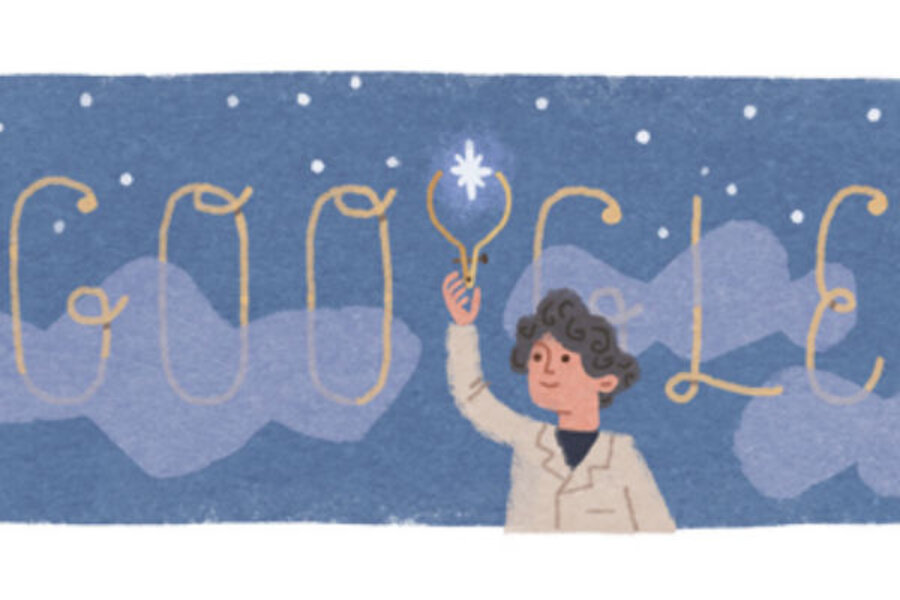Annie Jump Cannon: Why organizing the cosmos took a woman's touch
Loading...
When Annie Jump Cannon, the subject of Thursday's Google Doodle, joined the Harvard College Observatory in 1896, our picture of the universe was far different than it is today.
Today we know there are at least 100 billion galaxies, but for most scientists back then, there was just one: the Milky Way, which made up the entirety of the universe. Astronomers took that universe to be eternal and unchanging, somehow neither collapsing in on itself from gravity nor incinerating itself from the perpetual output of its stars.
While astronomers were building ever-larger telescopes to detect ever-fainter points of light in the sky, nobody knew quite what to make of those lights. How far away are they? How far apart? How big? How hot? And what, exactly, are they made of?
Astronomy at the end of the 19th century needed an organizer, someone to do what Carl Linnaeus did for biology, or Dmitri Mendeleev for chemistry. Someone to sort the stars.
This was the task assumed by the Harvard College Observatory. In 1885, its director, Edward Pickering, began working on an exhaustive catalogue of all the visible stars in the sky. Telescopes around the globe collected light from each star, which was passed through a prism that separated it into all the colors of the rainbow, which then produced a dark blotch on a photographic plate.
The blotches could be decoded. When light passes through a gas, the gas, according to its composition, will absorb certain wavelengths, allowing the rest of the light to pass through. When that remaining light travels through a prism, dark lines will appear in the resulting rainbow, a gaps showing the missing wavelength. Using this technique, known as spectroscopy, astronomers can lift a star's fingerprint.
Pickering had no shortage of fingerprints, but he lacked detectives to interpret them. Frustrated with the efforts of Harvard's male astronomers, Pickering, according to legend, announced that his maid could do the job better.
Pickering put this hypothesis to the test, and his maid-turned-astronomer, Williamina Fleming, proceeded to prove him correct in the ensuing decades by discovering hundreds of new stars and dozens of novae and nebulae.
Realizing that he was on to something with Fleming, Pickering set about hiring dozens of women to work at the observatory, creating one of the only places in the world at the time for women to practice astronomy. While the men worked nights operating the telescope and taking the photographs, the women would spend their days analyzing the plates, classifying each star's spectra, and performing complex calculations to determine their relative positions. They worked seven hours a day, six days a week, and, for their efforts, were paid between 25 cents and 35 cents an hour – more than the average factory worker, less than the average clerical worker, and about half of what was paid to the men .
By the time Cannon joined the Harvard observatory, "Pickering's Harem," as it became known, had catalogued thousands of stars, but it still lacked a coherent way to classify them. The prevailing method, favored by Fleming, arranged stars alphabetically, A through Q, according to the strength of the spectral lines that indicate hydrogen. Another method, favored by Cannon's colleague, Antonia Maury, sought to distinguish between the spectra from what would later be revealed to be giant and dwarf stars.
Both methods were becoming increasingly cumbersome. Cannon's insight was to eliminate some of letters in Fleming's method and rearrange the stellar classes according to surface temperature, from hot to cool: O, B, A, F, G, K, M.
Cannon published her first catalog of stellar spectra in 1901. In 1922, the International Astronomical Union formally adopted her system, and it is still used today.
She discovered no new laws and produced no new theories, but Cannon's influence on astronomy was nonetheless profound. And one of her colleagues at the observatory, Henrietta Swan Leavett, by comparing the brightness of a special kind of pulsating star called a Cepheid variable, devised the first way to measure distances between galaxies. Using her insights, astronomer Edwin Hubble determined that the universe is expanding, a discovery at the very heart of modern cosmology.






